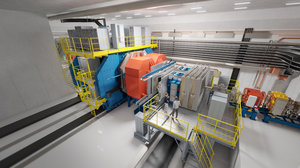
PANDA — Particle magic with antimatter
The strong force is the force that binds the elementary building blocks of matter, the quarks, into protons and neutrons, and then the protons and neutrons to nuclei. Despite its key role for the formation of matter, our understanding of the strong force is still far from complete. To study its properties in more detail, scientists have designed the PANDA experiment. Using beams of antiprotons, they want to create new particles that are predicted by theory but not yet observed. Moreover, they want to understand how mass is created by the strong force.
The PANDA detector


- weighs as much as 235 elephants: 700 tonnes;
- is as long as a truck with a trailer and as tall as a two-story building: 18 metres long, 6 metres tall, and 6 metres wide;
- can measure 100 million particle tracks per second with a precision of 50 micrometers;
- contains a superconducting magnet that is cooled down to -269°C;
- generates magnetic fields that could lift 480 tonnes of iron.
Particle and antiparticle
In the world of elementary particles, it is not magic that is needed to make something disappear and be replaced by something completely new: Instead, physicists can use antiparticles — the building blocks of antimatter. Every particle of ‘normal’ matter has its corresponding antiparticle. Although antimatter has the opposite electrical charge to normal matter and also differs in other ways, as far as we know it obeys the same physical laws. This means that we could not distinguish a world of antimatter from one of normal matter with the naked eye. Anti-gold would glisten like real gold and anti-water would ripple like normal water. It would be a kind of mirror world.
Annihilation — the destruction and creation of particles

What really makes this difference special, however, is that whenever a particle meets its antiparticle, they annihilate each other in a burst of free energy from which other, new particles can arise. This effect will be exploited for the PANDA experiment (Antiproton Annihilation at Darmstadt). Scientists will fire antiprotons at protons in order to create particles that will provide us with deeper insights into the mysterious strong force.
The strong force
The strong force is mediated by particles called gluons, and can be thought of as a kind of ‘rubber band’. It has the unusual property of becoming stronger as the distance between interacting quarks increases. It eventually becomes so strong that it is impossible to separate two quarks, because the amount of energy required to do so is so great that it would immediately create a new quark-antiquark pair. Theories describing the strong force predict a whole range of exotic particles consisting of different combinations of quarks and gluons. However, these particles have never been observed. They include ‘glueballs’, composite particles consisting solely of gluons. In the PANDA experiment, scientists want to use particle-antiparticle annihilation as a ‘trick’ to create such particles, and discover which of them actually exist and what their properties are. This would greatly increase our understanding of the strong force.
How does mass arise?
In this context, scientists also want to find out how particles come to have their mass. A proton, for example, weighs 50 times more than the three quarks composing it. Hence, the mass arises because the strong force (the gluons) binds the quarks together to create the proton. If scientists can improve our knowledge about the strong force with the help of the PANDA experiment, they might also enhance our understanding how matter gets its mass.











